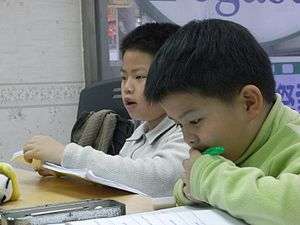Buxiban
| Buxiban | |||||||
 Taiwanese students studying English in an evening cram school | |||||||
| Chinese | 補習班 | ||||||
|---|---|---|---|---|---|---|---|
| |||||||
Buxiban (simplified Chinese: 补习班; traditional Chinese: 補習班; pinyin: bǔxíbān, lit. "remedial education classes") are cram schools in Mainland China and Taiwan.
It is a prevalent belief that parents should send their children to all kinds of cram schools in order for their children to remain competitive with their peers of the same age. As a result, many children of school-going age in Mainland China or Taiwan have schedules packed with all sorts of remediation from cram school.
Buxiban teach a variety of subjects, including math, Chinese characters, and English as a foreign language. Studying at several buxiban is widely perceived as necessary to get a high-enough college entrance exam score to attend prestigious universities.
Some buxiban are located in English-speaking countries. Most of those in North America are operated by the local communities. There, they are equivalent to hoshū jugyō kō (hoshūkō) in ethnic Japanese communities and hagwon in ethnic Korean communities. Buxiban began appearing in North America in the 1880s.[1]
See also
- Hagwon in Korea: 학원 hagwon
- Juku in Japan: 学習塾 gakushū juku
- Cram schools in Hong Kong: 補習社 bou2 zaap6 se5
- Buke
- Chinese school
References
- ↑ Hirvela, Alan. "Diverse Literacy Practices among Asian Populations: Implications for Theory and Pedagogy" (Chapter 5). In: Farr, Marcia, Lisya Seloni, and Juyoung Song (editors). Ethnolinguistic Diversity and Education: Language, Literacy and Culture. Routledge, January 25, 2011. Start page 99. ISBN 1135183708, 9781135183707. - Cited: p. 103. "These, too, exist as a result of efforts made by local ethnic communities. Chinese (buxiban) and Korean (hagwon) schools are the most dominant of these learning environments, while Japanese heritage schools (hoshuko) also exist in certain communities. The Chinese schools, which began appearing in the late 1880s, are mostly community run[...]"
External links
- The problems with English teaching in Taiwan
- Education - Reform Fattens Cram School Coffers
- Solutions to Taiwan's Education Woes - The Government: Five Urgent Tasks
- Education Reform - Excellent Teachers Nurture Creative Students
- OECD’s PISA, Media Sensationalism, and Education Reform in Japan
- Taiwan’s vocational education must be reformed
- Five questions on regulating for-profit colleges
- 40% of foreign teachers may have fake credentials: report
- Parents' Attitudes toward the English Education Policy in Taiwan
Further reading
- Zhou, Min and Kim, Susan S. (University of California, Los Angeles). "Community forces, social capital, and educational achievement: The case of supplementary education in the Chinese and Korean immigrant communities" (Archive). Harvard Educational Review, 2006. 76 (1), 1-29.